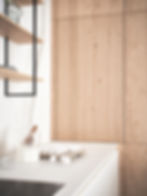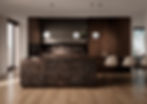%20(Large).jpg)
Inspiration Guides
Modern kitchens
Clean lines, uncluttered surfaces, and purposeful design—modern kitchens embody simplicity, focusing on form and function. Though often confused with contemporary style, modern design has its roots and personality. This guide explores what makes a kitchen modern, how it differs from contemporary kitchens, and how to style a modern kitchen that still feels warm and livable.
What Makes a Kitchen "Modern"?
Modern kitchen design emerged in the early to mid-20th century, drawing inspiration from the Bauhaus and mid-century modern movements. It emphasizes function, simplicity, and an absence of unnecessary ornamentation. Think flat-panel cabinets, integrated handles, geometric shapes, and a clean, overall aesthetic. Materials are often sleek and honest, featuring matte laminates, lacquers, stainless steel, wood veneers, and occasionally concrete.
.jpg)
Modern vs. Contemporary Kitchens: What’s the Difference?
The terms are often used interchangeably, but there’s a subtle difference. Modern kitchens adhere to a more defined set of principles rooted in historical design movements. They tend to favor consistency, warm woods, and architectural simplicity. Contemporary kitchens, on the other hand, evolve with the moment. They may incorporate modern elements but blend them with current design trends, such as mixed materials or playful color palettes.
So, modern might be better after a more timeless, structured look. If you enjoy keeping up with design trends and favor fluidity, contemporary could be your style.
The Role of Color and Texture
Modern kitchens often rely on a limited color palette. Neutrals like white, black, grey, or beige set the tone, while textures add interest. A matte finish, such as supermatt kitchen cabinets, provides a soft, elegant look. For more depth, you might incorporate wood-grain laminates or stone countertops.
Color isn't off-limits—it’s just used with restraint. A bold blue kitchen island or a wall painted in warm terracotta can serve as a beautiful counterpoint to the minimalism of the rest of the space.
Cabinets and Layout: Clean, Functional, Smart
Cabinetry is the backbone of any modern kitchen. Think handleless cabinets, flush fronts, and minimalist profiles. Storage is highly considered—nothing is excessive, and everything has a place. Many modern kitchens incorporate built-in elements like banquettes or open shelving in subtle tones.
The layout should feel natural and efficient. Open-plan spaces are common, with the kitchen flowing into living or dining areas. Kitchen islands are often central—not just visually but functionally, offering prep space, seating, and storage.
How Modern Connects to Other Styles
One of the great strengths of modern kitchens is how well they connect to other design languages. A Scandinavian kitchen can be seen as a branch of modernism, using pale woods and clean geometry. Similarly, transitional kitchens borrow from traditional and modern aesthetics to strike a perfect balance.
There’s room for overlap with minimalist kitchens, which strip things down even further—sometimes removing upper cabinets entirely and emphasizing negative space.
Modern kitchens offer the perfect mix of design-forward aesthetics and long-term livability. If you're looking for something clean, timeless, and functional, modern is hard to go wrong with.
For more inspiration, check out our guides on classic kitchens, mid-century modern kitchens, or visit our kitchen showroom to experience it in person.
.jpg)
.jpg)
.jpg)
.jpg)
%20(Large).jpg)
.jpg)
.jpg)



.jpg)

.jpg)
.jpg)
.jpg)
%20(Large).jpg)

.jpg)

%20(Large).jpg)

.jpg)
.jpg)
.jpg)

%20(Large)_edited.jpg)
.jpg)
.jpg)

_edited.jpg)
_edited.jpg)